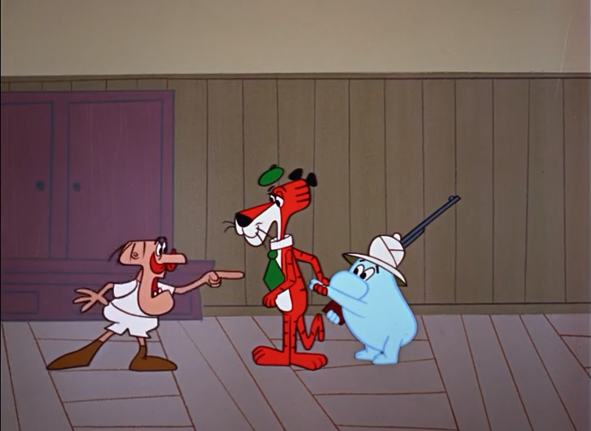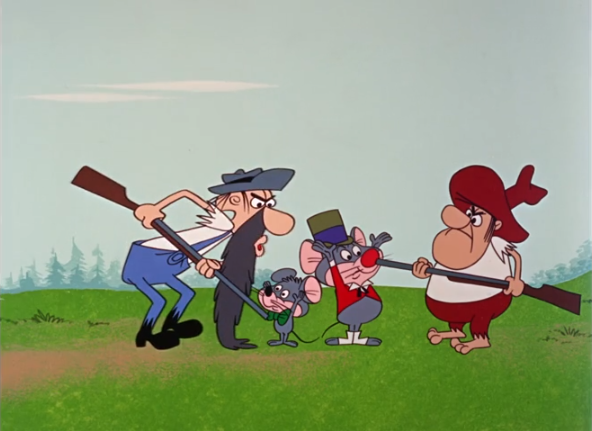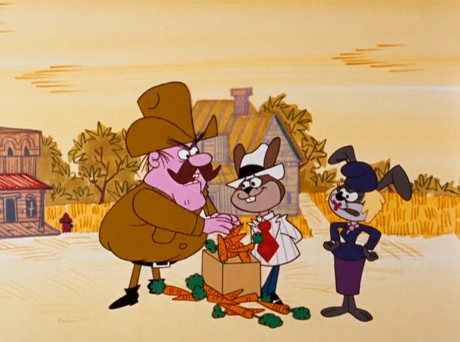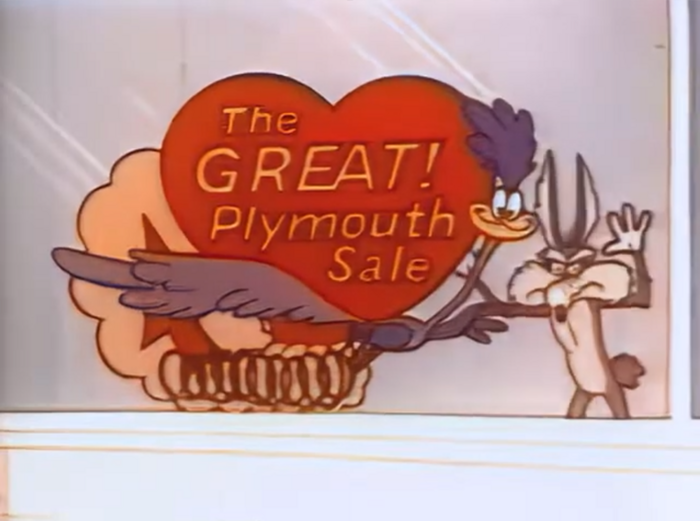1968: Cool Cat, cars and copters
The second year of the new Warner Bros.-Seven Arts animation studio brings us ten Looney Tunes and Merrie Melodies with old and new faces, as well as various additional projects.
Hocus Pocus Powwow
Directed by Alex Lovy
Merlin and Second Banana get kicked out of the train while traveling to perform in Powwow City. Lo, the poor Indian sees them and tries to steal Merlin's magic hat, leading to a wild chase. Apart from the dated stereotypes (which have largely kept this short out of circulation), this is a good effort for the time. Merlin is an amusing character, while Second Banana largely gets overshadowed by him and the stereotypical Native American. Larry Storch took over voicing both leads from now on. Quite fast-paced with nice uses of Merlin's magic (he can summon a railroad crossing out of nowhere, for example).
8

Big Game Haunt
Directed by Alex Lovy
Colonel Rimfire is again hunting Cool Cat, and the two run into an old house. But the two soon meet Spooky, a little ghost who's just trying to make friends, and try to escape from him. Another rather fast-paced cartoon – not as appealing as Cool Cat's debut, but certainly a watchable effort. Spooky is an entertaining character, though the concept is very similar to that of Casper the Friendly Ghost. I prefer this less saccharine version, to be honest! He was considered for a series of his own where he would have appeared with a boy named Buddy, but this turned out to be his only appearance.
7.5
Skyscraper Caper
Directed by Alex Lovy
Daffy is walking in his sleep and ends up in a pond. Speedy sees this and promises to watch the duck and wake him up if necessary, as long as he's paid five pesos. Speedy comes up with a plan to tie the bell to the bed to wake Daffy up and be able to get some sleep himself. But when the duck gets up on the other side of the bed, the mouse doesn't notice this. He must find Daffy and keep him from getting hurt on a construction site. A solid though not spectacular effort – while the start of the cartoon is slow, the second more action-packed half fares better. Both characters have unusually likable portrayals for the time, being portrayed as friends once again. This would have been a pretty good sendoff for the duo, but they have one more cartoon left...
8
Hippydrome Tiger
Directed by Alex Lovy
Colonel Rimfire and his robotic elephant Ella are once again after Cool Cat. But the tiger has gone to Paris for a car race. The hunter and his elephant attempt to catch him. Cool Cat outwits them while trying to win the race. Pretty average as far as cartoons go (nothing we haven't seen in the first two Cool Cats, except for the addition of cars), but there are a couple of fun gags and a lot of chase action. I'd have liked to see the car race play a bigger part!
7.5

Feud with a Dude
Directed by Alex Lovy
Merlin and Second Banana fly on their magic carpet and end up in the Ozarks where the Hatfields and the McCoys are feuding. The hillbillies soon unite to chase the two mice who use magic to escape. The short isn't my favorite with Merlin but decent for the time – some fun parts with random gags (especially the opening and ending), but for the most part it's quite ordinary cartoon comedy. The crew truly tried to add new characters, as "the Feudin' Mountain Boys" were yet another pair of one-shot characters that were considered for a series. I'm not surprised this didn't happen, as they're essentially indistinguishable from the various hillbilly characters we've seen over the decades.
7.5
See Ya Later Gladiator
Directed by Alex Lovy
A scientist has created a time machine. He tells his assistant Daffy to watch over the machine while he's asleep... and not to pull the lever! The duck is bothered by Speedy and his friends playing music outside. He comes up with a plan to send the mouse back to ancient Rome, but they both end up there, as gladiators. Often considered one of the worst Looney Tunes, I agree this one feels quite forced. There's very little that's memorable here, much of it feels worn out (it's the fourth cartoon in the last three years where Daffy is bothered by Speedy's music, for example), and the plot doesn't really suit Daffy and Speedy (who share the screen with generic human characters). Some nice surreal visuals during the time travel sequences and an amusing gag about traffic lights aren't enough to make this one a winner. Daffy makes his last appearance, a little over 31 years after his first appearance – this makes him the character with the longest span of appearances in the series, just beating Porky Pig. As Speedy also last appeared here, this was the final cartoon to feature any pre-1964 characters. They deserved a lot better!
6
3 Ring Wing-Ding
Directed by Alex Lovy
Colonel Rimfire sees a want ad – a circus will pay 1000 dollars for a live tiger. He sees this as a great opportunity to get rich and get rid of Cool Cat at the same time. The tiger runs away from the hunter, right into the circus, leading to a chase involving the various circus acts. Entertaining but nothing new apart from a couple of gags – Sylvester and Tweety did the chase around the circus even better. In addition to Cool Cat's fire-eating act, my favorite aspect here is the music. The circus music would find various uses later on, appearing on the rating cards before each cartoon (introduced in 1969) and then becoming the theme tune for "The Merrie Melodies Show" (one of the many Looney Tunes compilation shows on TV) in the early 70s. Colonel Rimfire had his last appearance here, as the remaining Cool Cat shorts would use other supporting characters.
7
Flying Circus
Directed by Alex Lovy
WWI combat pilots Ace and Fritz face off in the air after Ace accidentally lands on the wrong airfield. These wacky airplane antics seem to have been a common theme in cartoons back then: while WB had done similar shorts before (both versions of "Dumb Patrol"), this would soon be followed by DePatie-Freleng's Roland and Rattfink short "Hawks and Doves", as well as Hanna-Barbera's series "Dastardly and Muttley in Their Flying Machines" (which Lovy would work on). While the latter was much more memorable than this, it's still entertaining with its relentless pacing and occasional randomness.
7.5
Chimp & Zee
Directed by Alex Lovy
A professor is in the jungle, looking for the rare blue-tail simian. He immediately sees one hiding in a tree with his friend, a jungle boy (called Lonzo in production material). The two foil the professor's various attempts, and he also runs into problems with the other animals in the jungle. The gags are fast-paced and fun (and less predictable than in many cartoons from this period), the professor's voice acting is great (the first time in a while that Mel Blanc shows up in a non-Daffy and Speedy cartoon), and the animation works well despite its simplicity. The last W7 cartoon directed by Lovy, who returned to Hanna-Barbera where he would spend the rest of his animation career. His stint on the Looney Tunes and Merrie Melodies isn't very highly rated, but at least he leaves with what I found his best effort!
9
With Lovy gone, the studio needed a new director. The replacement they got was an impressive one – Looney Tunes veteran Robert McKimson left DePatie-Freleng to rejoin the W7 cartoon studio. Having been an animator at the studio since the early 30s, directed since the mid-40s and having only missed the last couple of years, he's a strong candidate for the most loyal crew member the cartoon series ever had! Will he manage to breathe new life into the series? We'll see some new characters in his cartoons, in addition to the ones Lovy had introduced.

Bunny and Claude: We Rob Carrot Patches
Directed by Bob McKimson
Two carrot-robbing rabbits, Bunny and Claude, commit crimes all over. The sheriff tries to stop them, but the duo is too clever for him. McKimson's return is a successful one – the cartoon is faster-paced and has stronger gags than most of the recent shorts. These two rabbits, obviously inspired by the 1967 Bonnie and Clyde movie, may not quite be the new Bugs Bunny, but they're likable in any case, showing some of the same trickster spirit – out of all the characters introduced in the W7 era, they're my favorites, and unlike many others, they would return for another appearance (they were in fact the last new characters to do so). Pat Woodell is charming as Bunny, and Mel Blanc is brilliant as always in his double role as Claude and the sheriff. But the absolute highlight for me here is the theme song: an extremely catchy country tune sung by Billy Strange, covering the two gangsters' exploits. Shorts like this show the studio could still deliver this late in the game.
9
CBS got the rights to broadcast "The Bugs Bunny Show", which was now combined with "The Road Runner Show" to form a new one-hour program. "The Bugs Bunny/Road Runner Hour" was a cheap production with little new animation, all of it directed by Robert McKimson. Instead of creating new bridging segments, ones from both earlier shows were reused, along with old Road Runner scenes set to "The Road Runner Show" theme. The opening combined the two theme songs, with a brief new sequence of Bugs introducing the Road Runner in between. Short commercial break bumpers were created with Wile E. chasing the Road Runner on stage while Bugs hosted, and the closing credits had another new sequence with the coyote wrecking Bugs' car while trying to catch the fast bird. This was a very rare case of the W7 cartoon studio creating new animation of these three characters, as none of them appeared in theatrical shorts anymore.
However, the W7 crew did also animate the Coyote and the Road Runner on another occasion. The two characters appeared in several commercials for the new Plymouth Road Runner car which used the bird's beeping noise for its horn. Out of all the Looney Tunes commercials, these are among my favorites, as most of them are very much in the spirit of the original cartoons with their gags, and the visuals are nice for the time. Some of the ads also combine animation and live-action sequences.
In addition to the Looney Tunes and Merrie Melodies, the crew created an additional short labeled as a "Cartoon Special", based on and featuring a song by Peter, Paul and Mary.
Norman Normal
Directed by Alex Lovy
Norman shows us what's behind a door. His boss tries to get him to take a man to the nightclub, get him drunk and make him sign a contract. Norman asks his father what's wrong and right, and we see him at a party, not wanting to get drunk despite others' insistence. Very different from the usual WB cartoon – instead of the usual slapstick, this one has a more adult take, with its message about non-conformity. We see how the times are changing, with Norman not wanting to hear a joke making fun of a minority group (though this feels a bit hollow, having been released right after "Hocus Pocus Powwow"). This different approach is probably largely down to different writers (N. Paul Stookey and Dave Dixon were responsible for both the story and the voices, their only W7 cartoon contribution). While a bit strange, it's definitely an interesting short with good visuals and an enjoyable rock-tinged a cappella theme song. While the short never got a sequel, it has gained a cult following of sorts, and it's certainly good to see the crew experimenting a little more!
8
The W7 cartoon studio also produced a short for Lockheed-California Company, showcasing the proposed AH-56A Cheyenne attack helicopter. It was the first of multiple W7 cartoons commissioned by Lockheed...
Is This Mission Impossible?
This short demonstrates how the AH-56A Cheyenne, a reconnaissance version of an existing helicopter, can soon achieve things considered impossible with current equipment. We follow the aircraft on a mission in the Vietnam War. Enemy movement is spotted using new technology, the pilot avoids enemy fire and eventually destroys their vehicles. A strictly informative and promotional short, with unusually realistic but limited animation of the helicopter and human figures. Predictably, this one is mostly of historical interest, in addition to showing how the W7 crew was capable of producing a very different kind of animation from their usual fare.
7
Warner Bros.-Seven Arts also released an independent cartoon produced by the Campbell, Silver, Cosby Corporation. This was the first time since the 30s that WB had released an animated short not produced by the same studio responsible for the Looney Tunes and the Merrie Melodies at the time. Producer/director Mundie did have a previous WB connection, having designed the opening titles for the 1965 live-action film "The Great Race" (which also featured sound effects by the legendary Treg Brown).
The Door
Directed by Ken Mundie
A Native American man is fishing, while another one is hunting. The two eat some fruit from a tree before meeting a woman who gives them a key, after which a door appears. The strangest animated short ever released by Warner Bros. – the whole thing has a very experimental vibe. Watercolor, stylized designs, the combination of animation and live-action footage (including that of protests and war), all of it accompanied by the jazz music and scat singing of Clark "Mumbles" Terry, who got that nickname for a reason! The anti-war message is rather obvious, otherwise the best word to describe this is "weird". It's a fascinating film, for sure, in part because it doesn't resemble any other cartoon ever released by WB.
8
Thanks to the Seven Arts merger, most of the Porky and Daffy cartoons formerly owned by Guild Films would now be included in the W7 syndication package along with the later cartoons. However, as TV channels were switching to color content, the appeal of black and white cartoons was decreasing. Consequently, Warner Bros.-Seven Arts decided to have colorized versions of them created in South Korea. As the original artwork no longer existed, all the animation and backgrounds had to be recreated. Sadly, the fact that this was done cheaply and quickly was obvious – not every frame was retraced, leading to choppy animation. There were questionable color choices along with various technical errors. As a positive, these versions would keep the classic shorts on TV for decades, eventually getting replaced with new computer colorized versions in the 90s, and later the black and white originals.
The year 1968 was a surprisingly eventful one for W7, with various projects. The Looney Tunes and Merrie Melodies had one of their less remarkable years, though it wasn't without its peaks. Lovy leaving and McKimson returning sets up an interesting 1969, but there won't be much more time left for the studio...
-
 2
2




2 Comments
Recommended Comments
Create an account or sign in to comment
You need to be a member in order to leave a comment
Create an account
Sign up for a new account in our community. It's easy!
Join the herd!Sign in
Already have an account? Sign in here.
Sign In Now